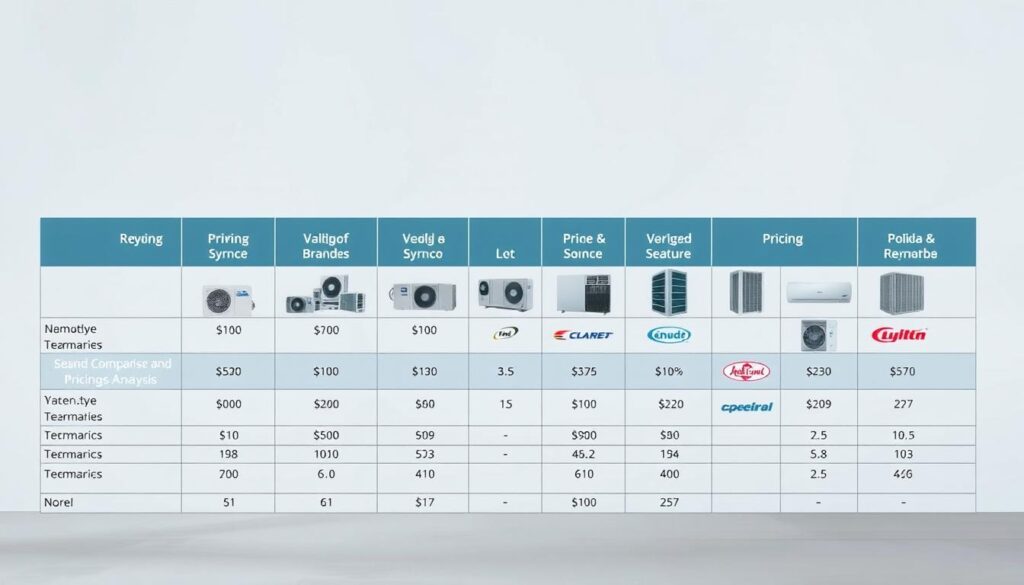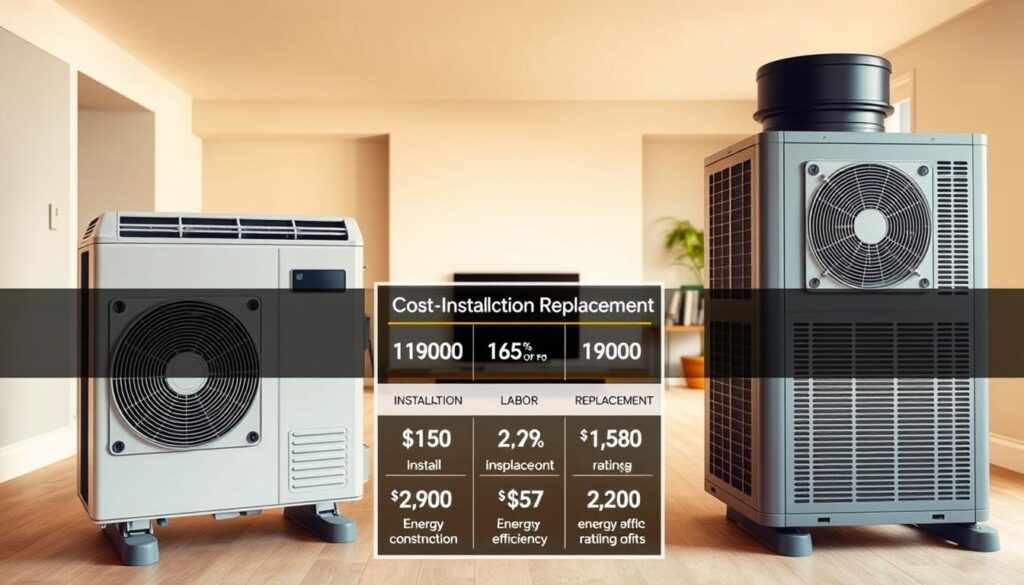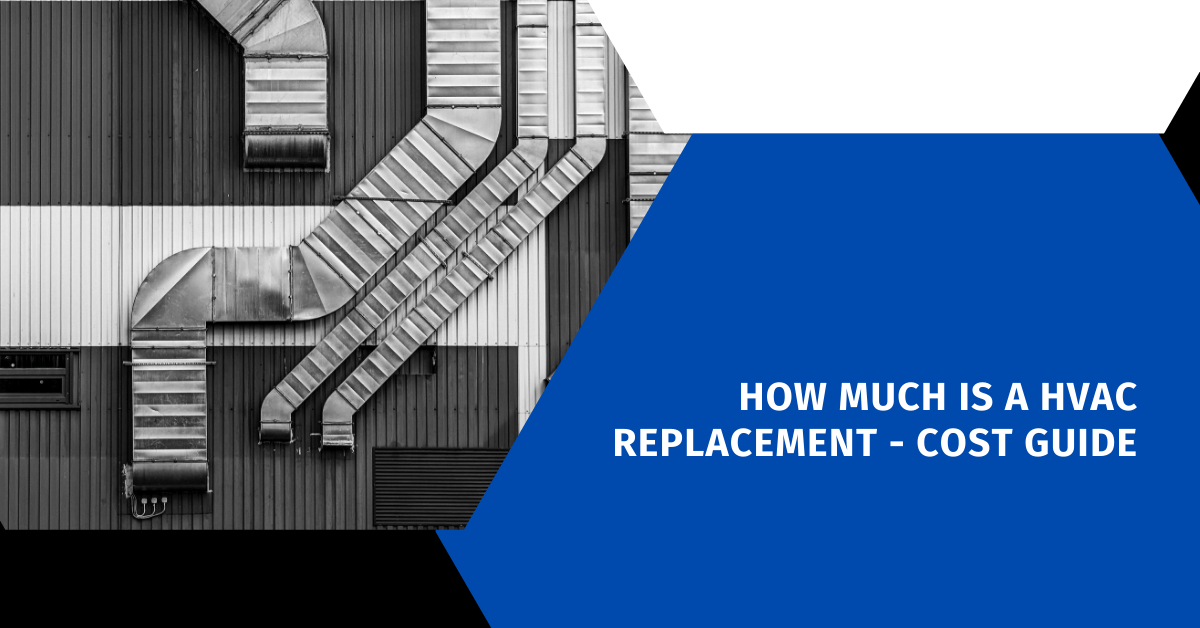Affiliate Disclosure
HVAC Guide Guys is a participant in the Amazon Services LLC Associates Program, an affiliate advertising program designed to provide a means for sites to earn advertising fees by advertising and linking to Amazon.
How Much Is A HVAC Replacement? Are you curious about the cost of a new HVAC system for your home? The price can vary a lot, making it hard for homeowners to guess the cost.

Knowing the cost of a new HVAC system is key for homeowners looking to upgrade. The price usually falls between $5,000 and $11,000. This depends on the system type, your home’s size, and how complex the installation is.
This guide will help you understand the costs of HVAC replacement. We’ll cover everything from system components to pricing strategies. You’ll learn all you need to know about the cost of a new HVAC system.
Key Takeaways
- HVAC replacement costs average between $5,000 and $11,000
- Total installation with ductwork can range from $7,000 to $16,000
- Multiple factors influence overall replacement expenses
- System type and home size significantly impact pricing
- Energy efficiency can affect long-term cost savings
Table of Contents
Understanding HVAC System Replacement Basics
Your home’s heating and cooling cost depends on knowing about HVAC systems. These systems keep your home’s temperature and air quality just right.
When you get a new HVAC system, it has many important parts. These parts help control the temperature and air flow in your home. Here are the main parts you’ll find:
- Heating units (furnaces or heat pump)
- Cooling units (air conditioners)
- Ventilation systems
- Ductwork and air distribution networks
- Thermostat and control mechanisms
Key Replacement Considerations
Knowing when to replace your HVAC system can save you a lot of money. It can also prevent sudden breakdowns. You might need a new system if:
- Your system is over 10-15 years old
- You’re spending a lot on repairs
- Room temperatures are not even
- Your energy bills keep going up
- Your system is too loud
Critical Replacement Factors
Several important factors affect the cost of replacing your HVAC system. You need to weigh the upfront cost against long-term savings. Getting a professional opinion is essential for making the right choice.
Choosing the right HVAC system can cut energy use by up to 40% compared to older models.
Average HVAC Replacement Costs Nationwide
Knowing the average cost of HVAC replacement across the U.S. helps with budgeting. The cost usually falls between $5,000 and $11,000. Most people spend about $8,000 for a full installation.
The cost of replacing your central air conditioning depends on several things:
- Where you live and local prices
- The size and layout of your home
- The type and efficiency of the system you choose
- If you need new ductwork or other changes
Prices can change a lot based on your situation. Rural areas might be cheaper, but cities like New York or San Francisco could be more expensive. Local labor costs, permits, and climate also affect the price.
To find the best price for your central air replacement, follow these tips:
- Get quotes from licensed HVAC contractors
- Compare the systems and their efficiency
- Look for rebates and tax breaks
- Think about how much you’ll save on energy in the long run
Pro tip: Don’t just pick the cheapest option. Look at the value, including the quality of installation, warranty, and how efficient the system is.
Explore Our HVAC Shop
Looking for top-rated HVAC tools, parts, and accessories? Visit our shop and find the perfect solution for your needs.
Visit the ShopHow Much Is A HVAC Replacement By System Type
Choosing the right HVAC system for your home is key. It affects your comfort and energy use. This guide helps you understand the costs of different HVAC systems. It’s important for making a smart choice.
Central Air Conditioning Units
Central air conditioning units are a top pick for cooling homes. Prices vary from $2,500 to $7,500. Several factors influence the cost:
- Home size and square footage
- Unit efficiency rating
- Brand quality
- Installation complexity
Furnace Systems
Furnace replacements keep your home warm. The cost depends on the fuel type:
| Furnace Type | Cost Range | Average Efficiency |
|---|---|---|
| Gas Furnace | $2,000 – $5,400 | 80-98% AFUE |
| Electric Furnace | $1,500 – $4,500 | 95-100% AFUE |
| Oil Furnace | $3,000 – $6,000 | 80-90% AFUE |
Heat Pump Options
Heat pump systems are great for both heating and cooling. They cost between $3,800 and $8,200. They’re efficient and control temperature all year.
- Air-source heat pump
- Geothermal heat pump
- Ductless mini-split systems
Pro tip: Always consider your local climate and home size when selecting an HVAC system for optimal performance and cost-effectiveness.
Size and Capacity Considerations
Choosing the right size for your whole house HVAC is key for good performance and energy use. The size of your HVAC system affects how well it heats and cools your home.
HVAC systems are measured in British Thermal Units (BTUs). BTUs show how much heat is needed to change the temperature of one pound of water by one degree Fahrenheit. Knowing BTU needs helps homeowners pick the best HVAC for their home.
Factors Affecting HVAC System Sizing
- Home square footage
- Ceiling height
- Insulation quality
- Number of windows
- Regional climate conditions
Experts use detailed calculations to find the exact system size for your home. An undersized system will struggle to keep temperatures comfortable. On the other hand, an oversized system wastes energy and raises utility bills.
BTU Recommendations by Space
| Space Size | Cooling BTUs | Heating BTUs |
|---|---|---|
| 500 sq ft | 8,000-12,000 | 12,500-25,000 |
| 1,000 sq ft | 16,000-24,000 | 25,000-50,000 |
| 1,500 sq ft | 24,000-36,000 | 37,500-75,000 |
When getting a new HVAC, talk to a pro who can check your home’s heating and cooling needs. This way, you get a system that’s comfy and saves energy.
Explore Our HVAC Shop
Looking for top-rated HVAC tools, parts, and accessories? Visit our shop and find the perfect solution for your needs.
Visit the ShopLabor Costs and Installation Expenses
When planning to replace your HVAC unit, it’s important to understand labor costs and installation expenses. The price for HVAC installation can change a lot. This depends on several key factors that affect your total cost.
Standard Installation Pricing Breakdown
HVAC labor rates usually fall between $75 and $150 per hour. This rate is a big part of the cost of replacing your HVAC unit. Professional installers do a lot of work to make sure your system works well.
- Basic installation: 1-2 days for existing ductwork
- Complex installation: 3-5 days for new ductwork
- Average labor costs: $1,500 – $3,500
Additional Labor Requirements
Some HVAC replacement projects need extra work. This can make installation costs go up. These extra tasks might include:
- Electrical system upgrades
- Ductwork modifications
- Permit acquisition
- Removal of old equipment
Regional Cost Variations
Your location affects installation costs. Places with higher living costs, like cities, have pricier labor rates. Local competition, market demand, and contractor expertise also play a role in pricing.
Pro Tip: Always get multiple quotes from licensed HVAC professionals. This way, you can find the best price and quality installation.
Brand Comparison and Pricing Analysis
When looking at new HVAC systems, it’s key to know the prices and performance of different brands. The cost of a new HVAC system can vary a lot, from very affordable to quite expensive.

Popular HVAC brands have different prices and benefits. Here are some of the main players:
- Carrier: Known for high-quality, reliable systems with premium pricing
- Goodman: Offers affordable solutions for budget-conscious homeowners
- Trane: Provides top-tier performance with advanced technology
- Lennox: Specializes in energy-efficient systems with higher initial costs
Here’s a quick comparison of average system costs:
| Brand | Average System Cost | Efficiency Rating |
|---|---|---|
| Carrier | $6,500 – $10,000 | Up to 21 SEER |
| Goodman | $3,500 – $6,000 | Up to 18 SEER |
| Trane | $7,000 – $11,000 | Up to 22 SEER |
| Lennox | $6,800 – $10,500 | Up to 23 SEER |
“Selecting the right HVAC brand is about balancing upfront costs with long-term performance and energy savings.”
Your choice should depend on your budget, home size, and energy efficiency goals. While premium brands like Trane and Carrier offer advanced features, more affordable options like Goodman can provide reliable performance at a lower cost of new HVAC system.
Explore Our HVAC Shop
Looking for top-rated HVAC tools, parts, and accessories? Visit our shop and find the perfect solution for your needs.
Visit the ShopExplore Our HVAC Shop
Looking for top-rated HVAC tools, parts, and accessories? Visit our shop and find the perfect solution for your needs.
Visit the ShopEnergy Efficiency and SEER Ratings Impact
When looking at home heating and cooling costs, energy efficiency is key. The price of upgrading your HVAC system isn’t just about the first cost. It’s also about saving money in the long run with smart technology choices.
Understanding SEER Ratings
SEER (Seasonal Energy Efficiency Ratio) shows how well your HVAC system cools. It’s like a miles-per-gallon rating for your air conditioner. The higher the SEER rating, the better the system’s energy use.
- SEER ratings range from 13 to 26
- Minimum federal standard is 13 SEER
- High-efficiency systems start at 16 SEER
Cost vs. Energy Savings
Choosing a high-efficiency system might raise your initial cost. But the long-term benefits are big. A system with a higher SEER rating can cut your energy bills by 20-40% each year.
Long-term Financial Benefits
Your HVAC system upgrade cost should include energy savings. A more efficient system might cost more at first. But it can save you a lot of money over time by using less energy.
Energy-efficient systems are an investment in both comfort and financial savings.
Ductwork Considerations and Costs
When you’re getting a new HVAC system, ductwork is key. It’s like the veins of your home, carrying air to every room. Good ductwork means your home stays comfy.
- Uneven temperature in rooms
- High energy bills
- Dust building up fast
- Strange sounds from vents
Getting a new HVAC system might mean changing or replacing ducts. Costs can be $1,400 to $5,600 for replacement or $2,400 to $6,600 for new ones.
| Ductwork Type | Average Cost | Typical Lifespan |
|---|---|---|
| Flexible Ductwork | $1-$4 per linear foot | 10-15 years |
| Sheet Metal Ducts | $5-$10 per linear foot | 20-25 years |
| Fiberglass Ductboard | $3-$7 per linear foot | 15-20 years |
Your HVAC expert can tell you if you need repairs or a new setup. Good ductwork means your system works better and saves energy over time.
New Construction vs. Replacement Costs

Knowing the difference between installing HVAC in new homes and replacing it in old ones is key. This knowledge helps you understand the costs better. The costs for these two scenarios are quite different.
For new homes, HVAC installation costs between $1.75 and $2.50 per square foot. This lower price comes from several benefits:
- Easier access to installation areas
- No need for complex retrofitting
- Clean slate for system design
- Minimal demolition work required
Replacing HVAC in existing homes, on the other hand, comes with its own set of challenges. You might face extra costs for:
- Ductwork modifications
- Structural adjustments
- Potential electrical system upgrades
- Removing old equipment
Contractors usually charge more for replacements because of the added complexity. Your home’s age, layout, and current system will greatly affect the replacement costs.
Pro tip: Always get multiple quotes and understand the specific requirements of your home’s HVAC replacement project.
By planning carefully and understanding these cost differences, you can better budget for your HVAC upgrade.
Available Rebates and Tax Incentives
Looking to lower the cost of a new HVAC system? There are financial incentives that can help. Homeowners can find rebates and tax credits that make the initial cost more manageable.
Federal Tax Credit Programs
The federal government has tax credits for energy-saving HVAC systems. These credits can cut down on the cost of a new system. Some key programs include:
- Energy Star qualified central air conditioners
- High-efficiency heat pump systems
- Advanced main air circulating fans
State-Specific Incentives
States also offer rebates for energy-efficient upgrades. Your local utility company and state energy office are great places to find these incentives. Savings can be from $50 to $500, depending on where you live and the system you choose.
Manufacturer Rebates
HVAC makers often give rebates to help lower the cost of a new system. These deals usually happen during sales seasons. They can offer big discounts on new equipment.
Pro tip: Always check current rebate programs before buying.
To save the most, look for and use all available incentives. Websites like Energy Star and DSIRE can help you find programs.
Cost-Saving Strategies for HVAC Replacement
To lower the cost of replacing central air conditioning, plan carefully and make smart choices. When you replace your furnace and AC, there are ways to save money. These strategies can help you spend less.
Here are some effective ways to keep your HVAC replacement costs down:
- Schedule installation during off-peak seasons when contractors offer lower rates
- Replace heating and cooling systems simultaneously to reduce overall installation costs
- Select the appropriate system size to avoid unnecessary expenses
- Invest in energy-efficient models with higher SEER ratings
Timing is key when it comes to saving on furnace and AC replacement costs. Contractors often have less work in spring and fall. This can mean lower prices and possible discounts for you.
Smart homeowners understand that strategic planning can significantly reduce central air conditioning replacement expenses.
More ways to save include:
- Getting quotes from different HVAC contractors
- Looking for manufacturer rebates
- Checking for energy efficiency tax credits
- Keeping your current system running longer
By using these strategies, you can manage your HVAC replacement costs. You’ll also ensure your home stays comfortable and energy-efficient.
Conclusion
Figuring out the cost of a new HVAC system involves looking at several factors. This guide has given you the tools to make smart choices for your home’s heating and cooling. You now know about the key elements that affect the cost of replacing your HVAC.
When thinking about upgrading your HVAC, remember that quality pays off in the long run. Getting advice from experts and doing your homework is key. Think about your home’s size, the local weather, and how energy-efficient you want your system to be.
Choosing the right HVAC system is more than just the initial cost. It’s about making your home comfortable and energy-efficient. Look into different brands, check for rebates, and see how modern systems can save energy. With what you’ve learned, you can confidently pick a system that will keep your home comfortable for years.
By doing your research and planning carefully, you’ll end up with a more comfortable and energy-saving home. Take your time to consider your options, get advice from pros, and pick a system that fits your needs best.

